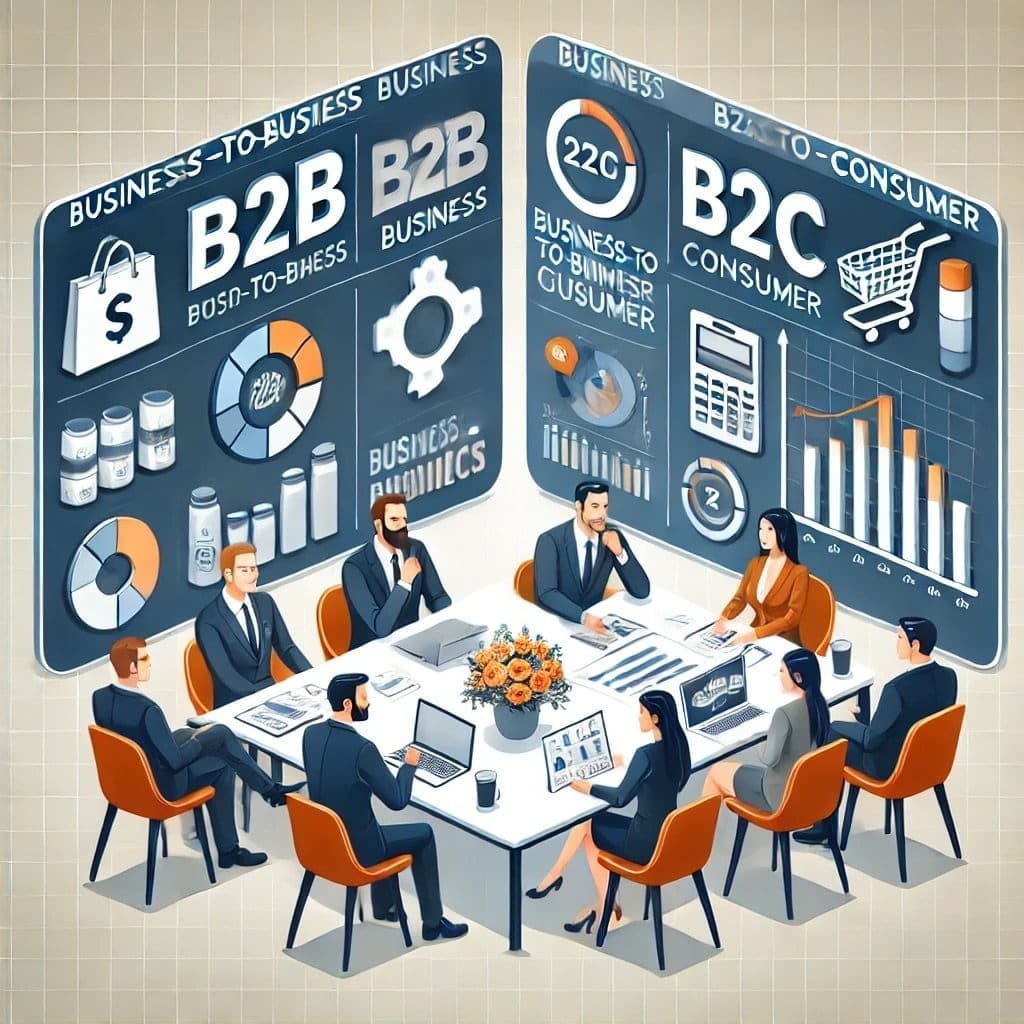Businesses generally fall into two main categories: B2B (Business-to-Business) and B2C (Business-to-Consumer). While both models involve selling products or services, their strategies, target audiences, and approaches differ significantly. Understanding these differences is essential for businesses to develop the right marketing, sales, and operational strategies.
This article explores the key differences between B2B and B2C models, including target audience, sales processes, marketing approaches, and customer relationships.
What is B2B (Business-to-Business)?
In the B2B model, businesses sell products or services directly to other businesses. B2B transactions typically involve higher-value products and long-term contracts, as businesses often purchase in bulk or require ongoing services.
Key Characteristics of B2B:
• Target Audience: Businesses, corporations, or government entities.
• Sales Process: Longer, more complex decision-making process involving multiple stakeholders.
• Products/Services: Often more specialized, such as software solutions, raw materials, or consulting services.
• Customer Relationship: Focus on building long-term partnerships.
Example of a B2B Company:
Salesforce, a cloud-based software company, provides customer relationship management (CRM) solutions to businesses looking to improve their sales and customer service operations.
What is B2C (Business-to-Consumer)?
In the B2C model, businesses sell products or services directly to individual consumers. These transactions are typically quicker, with a focus on delivering a seamless, convenient customer experience.
Key Characteristics of B2C:
• Target Audience: Individual consumers or households.
• Sales Process: Shorter decision-making process, often impulsive or emotion-driven.
• Products/Services: Consumer goods, retail products, and services like entertainment or healthcare.
• Customer Relationship: Focus on delivering a positive customer experience and encouraging repeat business.
Example of a B2C Company:
Amazon, the online retail giant, sells a wide range of consumer products directly to individual shoppers, offering convenience and quick delivery.
Differences Between B2B and B2C Models
1. Target Audience
The biggest difference between B2B and B2C models lies in the target audience.
• B2B: Targets other businesses, so the customer base is often smaller but more specialized. Decisions are based on rational factors like cost, efficiency, and ROI (return on investment).
• B2C: Targets individual consumers, so the customer base is much broader. Purchases are often driven by emotions, personal preferences, and convenience.
2. Sales Cycle
The sales process in B2B and B2C transactions varies significantly.
• B2B: The sales cycle is typically longer, involving multiple decision-makers such as managers, executives, or procurement teams. There is often a need for negotiations, demonstrations, and customized solutions.
• B2C: The sales cycle is much shorter, with most purchases being completed in one or a few steps. Consumers make decisions more quickly, often based on marketing messages, brand loyalty, or personal needs.
3. Decision-Making Process
The decision-making process in B2B is complex, while B2C decisions are more straightforward.
• B2B: Business purchases involve multiple stakeholders and are driven by rational considerations such as price, quality, and long-term benefits. Decisions are often made over weeks or months, as businesses seek to reduce risk.
• B2C: Consumers make decisions based on emotions, personal preferences, brand reputation, and convenience. Impulse buying is more common, and purchases are often completed in a matter of minutes or hours.
4. Marketing Strategies
Marketing strategies differ greatly between B2B and B2C.
• B2B: Marketing is more focused on building relationships, demonstrating expertise, and providing value through educational content. Common marketing tactics include:
• Content marketing: White papers, webinars, case studies.
• Email marketing: Personalized campaigns aimed at decision-makers.
• Account-based marketing (ABM): Targeting specific businesses or key accounts.
• B2C: Marketing is geared toward mass audiences and emotional appeal. Tactics include:
• Social media marketing: Platforms like Instagram, Facebook, and TikTok to engage with customers.
• Influencer marketing: Partnering with celebrities or social media influencers to promote products.
• Discounts and promotions: Offering sales, coupons, or flash deals to drive impulse purchases.
5. Customer Relationships
Customer relationships in B2B and B2C models also vary.
• B2B: Relationships are long-term and built on trust and reliability. B2B companies focus on maintaining strong, ongoing partnerships with clients, often involving account managers and personalized service.
• B2C: Relationships are more transactional and based on individual purchases. However, businesses aim to foster brand loyalty by providing excellent customer service, convenience, and rewards programs.
6. Pricing Models
Pricing in B2B is often more flexible and negotiable, while B2C pricing is usually fixed.
• B2B: Pricing is often customized based on volume, contract terms, and client needs. Businesses may offer tiered pricing, discounts for bulk purchases, or service level agreements (SLAs).
• B2C: Prices are typically fixed and displayed publicly. Consumers expect straightforward pricing with occasional discounts or promotions.
Which Model is Right for Your Business?
Choosing between a B2B and B2C model depends on your product, service, and target market. Consider the following:
• B2B: Ideal if your product or service solves a specific business problem, requires customization, or involves long-term contracts.
• B2C: Best for products or services aimed at individual consumers, especially if your offering can be sold at scale with minimal customization.
Some companies operate in both B2B and B2C spaces, offering different products or services for each market. For example, Microsoft sells enterprise software to businesses (B2B) while also offering consumer products like Xbox and Office 365 (B2C).
Conclusion
Understanding the fundamental differences between B2B and B2C models is essential for shaping your marketing, sales, and customer service strategies. While B2B focuses on long-term relationships, data-driven decisions, and personalized services, B2C prioritizes emotional appeal, convenience, and brand loyalty. By aligning your business model with your audience’s needs, you can optimize your approach and ensure long-term success.


